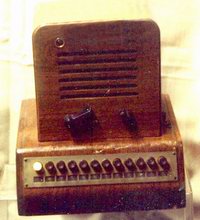ABOUT
REMOTE CONTROL SYSTEMS...
An Abridged History (and the Future) of Home Control
Chapter
1 – From Communications to Music
 A
traditional way to call for a servant used to be a bell, sometimes on
a cord by the master’s chair. Manual doorbells and speaking tubes
were common in houses of the 1900’s – actually an acoustic
tube extending from the front door to some location from which the homeowner
could shout back and forth to visitors - the early intercom. A
traditional way to call for a servant used to be a bell, sometimes on
a cord by the master’s chair. Manual doorbells and speaking tubes
were common in houses of the 1900’s – actually an acoustic
tube extending from the front door to some location from which the homeowner
could shout back and forth to visitors - the early intercom.
By the time electric
lights were common, businesses had discovered the value of true wired
intercoms, but it wasn’t until the ‘40s and 50’s that
wired intercoms and internal home telephone communication became common
even in wealthy homes.
But then it then
took no time at all before “music over the intercom” became
vogue, sharing tinny renderings from a central radio to several rooms.
The state of the art in 1959 was an in-wall AM clock-radio with switches
to turn on or off the music to individual rooms, while a talk lever
enabled announcements to be sent throughout the home. Fancy units like this lovely orange number even had a jack on the front
that let you play a phonograph into it, presuming you didn't mind a
phonograph on the kitchen sink... not to mention changing the record
every few minutes.
Fancy units like this lovely orange number even had a jack on the front
that let you play a phonograph into it, presuming you didn't mind a
phonograph on the kitchen sink... not to mention changing the record
every few minutes.
Next it was an 8-track
tape player, then a cassette, a CD, and now even satellite music sources.
Speakers and amplifiers have improved the sound, but the intercom model
of entertainment distribution generally fails to satisfy any but the
most background of music desires. Home owners liked the hidden equipment
and widespread coverage. They missed the quality listening experience
they had with a stack of components. The need to control sources and
provide stereo sound worthy of foreground listening has largely driven
entertainment distribution out of the intercom and into a separate system
evolution.
When distributed
music made it out on its own, it quickly diversified into flavors.
- In the most basic
whole-house music system with no distributed source control, usually
only a local volume control is used in each room. The same source
will play in every room, and is controlled from the central location.
A single powerful amplifier feeds the whole system as one load. This
is still a common design where cost is the major consideration.
- Better systems
offer selection of the entertainment source from each location in
addition to volume control. All rooms still share the same content
but it is selected from any room. A single amplifier may still be
used, but more wires are needed for control. Often these systems go
the next step and have separate amps for each room to provide better
sound.
- The best systems
allow each room to select and control sources independently from other
rooms for simultaneous enjoyment of different music in different locations.
While this requires more sophisticated switching and control along
with dedicated amplifiers, this design elevates each supported room,
or zone, to a separate and equal listening area.
However, until recently,
multi-room distribution of more than music has been difficult and not
widely utilized.
About Home Entertainment
- Introduction
This Chapter – From Communications to Music
Chapter 2 – TV goes Mobile
Chapter 3 – One Remote,
Two Remote, Three Remote, Four…
Chapter 4 – Automation
Platforms – The Rise of the Machines
Chapter 5 – The Next
Generation – User and Content Centric Control
Chapter 6 – Multi-zone
and Theater Convergence
|










 A
traditional way to call for a servant used to be a bell, sometimes on
a cord by the master’s chair. Manual doorbells and speaking tubes
were common in houses of the 1900’s – actually an acoustic
tube extending from the front door to some location from which the homeowner
could shout back and forth to visitors - the early intercom.
A
traditional way to call for a servant used to be a bell, sometimes on
a cord by the master’s chair. Manual doorbells and speaking tubes
were common in houses of the 1900’s – actually an acoustic
tube extending from the front door to some location from which the homeowner
could shout back and forth to visitors - the early intercom. Fancy units like this lovely orange number even had a jack on the front
that let you play a phonograph into it, presuming you didn't mind a
phonograph on the kitchen sink... not to mention changing the record
every few minutes.
Fancy units like this lovely orange number even had a jack on the front
that let you play a phonograph into it, presuming you didn't mind a
phonograph on the kitchen sink... not to mention changing the record
every few minutes.